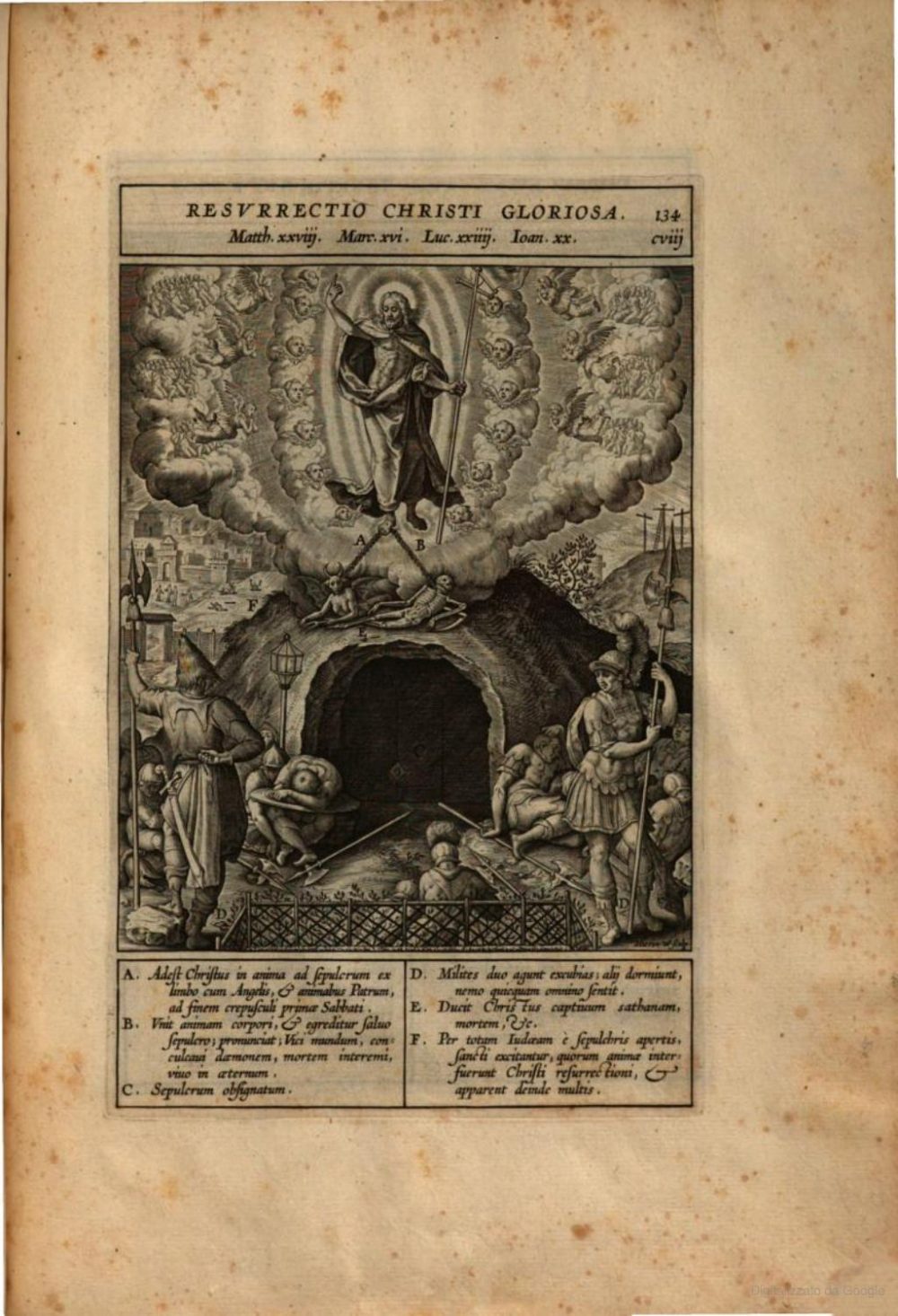
Internet archive (original from Getty Research Institute)
The Passion of Christ iconography was an important topic for Pacheco. When the author analysed the scene of the “Resurrection”, among several observations on how to do it, he states the inadequate manners to depict such a scene: the tomb of Christ opened and Christ takes one leg out to get out of it around it, also the terrified guards covering themselves, some with their shields and, behind, reaching for their swords. All these elements should be avoided.
“Without detriment to his integrity, and then he entered the upper room with the doors closed, by the gift of subtlety. With this majesty and beauty Christ our Lord must be painted, with his red robe and white cloth, his wounds uncovered and glorious, with great splendours of light, and let us not hide his triumphant banner and the accompaniment of angels and seraphim, as Father Geronimo Nadal put it. The sepulcher must be closed and sealed and the guards asleep;[…]. And, thus, what is commonly painted is remarkable nonsense: the guards attacking the Redeemer with swords and halberds, as if they wanted to offend him, or defend themselves with their shields; an ignorance that a modern author rightly warned of: ‘How the resurrection is painted and sculpted, culpably, is this way: A square tomb with the slab that covers it half open and Christ with one leg on the slab and taking the other out of the tomb through the opening of the; around it the terrified guards covering themselves, some with their shields and, behind, reaching for their swords; which is painted and sculpted with such indecency that it detracts from devotion. This way of painting against the truth of the holy Gospel is seen in the last chapter of St. Matthew, […]. I have seen it painted many times, and in Xerez de la Frontera, on the door of the convent of the Recogidas, it is sculpted in stone, and I believe that Juan Molano did not overlook it in his book De imágenes sagradas (On sacred images)”.
“Sin detrimento de su integridad y, después, entró en el cenáculo cerradas las puertas, por el don de la sutilidad. Con esta majestad y hermosura se ha de pintar Cristo nuestro Señor, con su manto roxo y paño blaco, descubiertas y gloriosas sus llagas, con grandes resplandores de luz y no escusemos su bandera triunfante y acompañamiento de ángeles y serafines, como lo puso el P. Gerónimo Nadal. El sepulcro ha de estar cerrado y sellado y las guardas durmiendo;[…]. Y, así, es disparate notable lo que comúnmente se pinta: las guardas acometiendo al Redentor con las espadas y alabardas, como queriendolo ofender, o defenderse con los escudos; ignorancia que advirtió, doctamente, un autor moderno: ‘El modo con que se pinta y esculpe, culpablemente, la resurrección es desta suerte: un sepulcro cuadrado con la lasa que la cubre medio abierta y Cristo con la una pierna sobre la losa e sacando la otra del sepulcro por la abertura del; alrededor las guardas despavoridas cubriendose, unas las cabear con los escudas y, atrás, echando mano a las espadas; lo cual pintan y esculpen con tanta indecencia que quitan la devoción. Este modo de pintar contra la verdad del santo Evangelio se ve en el último capítulo de San Mateo, […]. Esto del sepulcro abierto y Cristo sacando una pierna dél para salir, lo he visto muchas veces pintado y en Xerez de la Frontera, en la puerta del convento de las Recogidas, está esculpida en piedra, y creo que no se le pasó por alto a Juan Molano en su libro De imágenes sagradas”.
Pacheco 1990, 649, n.49, 53



